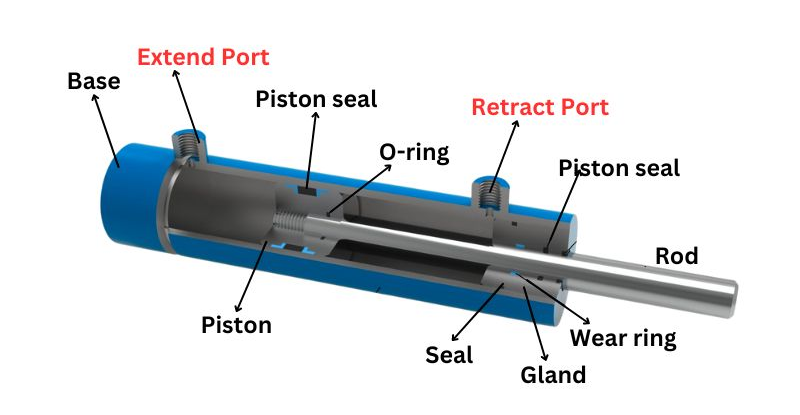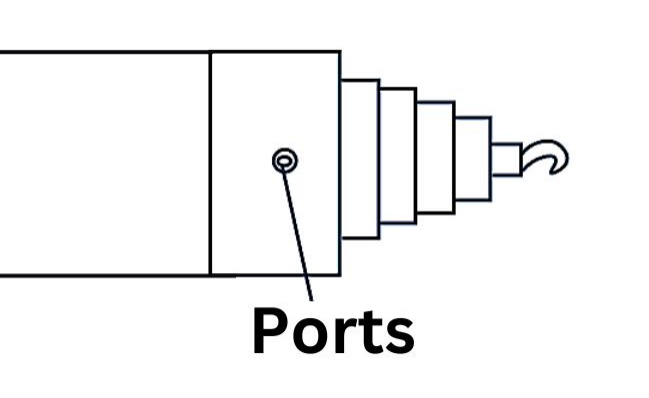Hydraulic cylinders stand as vital elements in contemporary machinery, exerting a pivotal role across diverse industrial sectors. At the heart of their operation lie the hydraulic cylinder ports, which are instrumental in enabling the regulated inflow and outflow of hydraulic fluids. This article delves deep into the complexities surrounding these ports, elucidating their various types, design contemplations, the influence they exert on cylinder efficacy, and the requisites for their upkeep. Comprehending the nuances of these ports transcends mere mechanical understanding; it is central to ensuring the enhanced performance and prolonged lifespan of hydraulic systems.

Hydraulic cylinder ports play an indispensable role in the system's functionality. Strategically positioned on the cylinder housing, they act as conduits for the hydraulic fluid, serving as critical access points. Their core responsibility entails regulating the influx and discharge of this fluid—the hydraulic system's vitality. As fluid passage occurs via these ports, pressure is generated, thereby propelling the piston's motion and facilitating the execution of tasks.
To elaborate on port varieties, SAE ports are renowned for their robust sealing properties, rendering them a favored option in high-pressure operational contexts. Conversely, NPT ports utilize tapered threading to establish a secure seal through screw engagement, typically employed in broad application scenarios. ISO-standard ports, designed in adherence to international norms, exhibit adaptability and are the preference for installations necessitating worldwide interoperability. The choice amongst these is far from arbitrary; it pivots upon parameters including the cylinder's operational pressure thresholds, ambient conditions, and the specific characteristics of the hydraulic fluid in use.
The proficiency of a hydraulic cylinder is significantly determined by the proficiency of its ports in managing fluid mechanics. Engineered to augment fluid flow rate and trajectory, these ports are pivotal in dictating the velocity and power of the piston's movement—swift fluid ingress equates to rapid piston displacement. Conversely, modulated fluid discharge facilitates a seamless piston return. Optimal port configuration is also imperative for preserving system integrity, averting complications such as cavitation and air entrapment, which can engender inefficiencies and harm. Consequently, the calculated positioning of these ports constitutes a cardinal aspect of cylinder blueprinting, guaranteeing the system's flawless operation across a spectrum of load and stress environments.
1.Customization for Application Needs Expanded: The configuration of hydraulic ports is meticulously adapted to fulfill the extensive requisites of myriad applications. Elements such as the mandatory pressure classifications, fluid velocity, and the specific nature of the hydraulic liquid in usage form the crux of this design methodology. High-pressure systems, for example, call for ports engineered to withstand such rigorous conditions unfailingly, while the velocity of fluid flow governs the dimensions and structure of the port to guarantee unimpeded fluid dynamics. Furthermore, the fluid's composition, be it oil-based or water-based, impacts the selection of port materials and coatings, safeguarding against corrosive effects and thereby ensuring a prolonged service life.
2.Material Selection Expanded: The selection of the material for constructing hydraulic cylinder ports is crucial to ensuring their longevity and optimal performance. Commonly employed materials include steel, stainless steel, and brass, each with distinct advantages. Steel, distinguished by its robustness and durability, is well-suited for high-pressure operational environments. Stainless steel, renowned for its inherent corrosion-resistant traits, is the preferred choice in scenarios where either the hydraulic medium or the ambient conditions pose corrosion risks. Conversely, brass ports are favored due to their corrosion-resistant properties and broad compatibility with a multitude of hydraulic fluids.
3.Thread Design and Sealing Mechanisms Expanded: The reliability of hydraulic cylinder ports is significantly dependent on their thread designs and sealing strategies. Threads, designed according to standards such as NPT or ISO, are meticulously selected to guarantee a secure, leak-proof assembly capable of withstanding the system’s operational pressures. Complementary sealing measures, including O-rings or the application of Teflon tape, augment these connections, effectively hindering fluid leaks that could otherwise lead to systemic inefficiencies or outright failures. The meticulous choice of these elements is vital not just for upholding the overall integrity of the hydraulic system but also for assuring safety and unwavering reliability during operations.
1.Efficiency Expanded: The strategic location of hydraulic cylinder ports is crucial for achieving maximum operational efficiency. Ports that are correctly situated promote a streamlined hydraulic fluid flow, thereby minimizing turbulence and reducing energy loss within the system. This optimization of fluid dynamics directly enhances the cylinder's responsiveness and performance, resulting in a more efficient operational capacity. particularly in high-performance contexts, even marginal enhancements in fluid behavior can yield substantial improvements in the overall system's efficiency.
2.Maintenance and Accessibility Expanded: The ease of access to hydraulic cylinder ports is a paramount factor in maintenance planning. Ports that are optimally situated facilitate straightforward inspection, servicing, and any necessary repairs, effectively curtailing downtime and reducing maintenance expenses. Specifically, those ports that can be easily reached without dismantling major machine components expedite routine inspections and fluid replacements. Enhanced accessibility in this regard not only streamlines maintenance tasks but also fosters a culture of consistent maintenance, which is fundamental to the extended lifespan and dependable functioning of hydraulic systems.
1.Single-Acting Cylinders Expanded: In single-acting hydraulic cylinders, the use of a solitary port indicates a simpler design approach. The hydraulic fluid is introduced through this port, generating pressure that propels the piston in a single direction, customarily for lifting or pushing operations. Upon pressure release, a spring mechanism or an external influence, such as gravity, facilitates the piston's return to its initial position. This configuration is prevalent in scenarios where a unidirectional force suffices and where the emphasis rests on simplicity and cost-efficiency.
2.Double-Acting Cylinders Expanded: Double-acting cylinders, featuring two distinct ports, provide enhanced flexibility in operation. One port serves to admit hydraulic fluid, driving the piston forward, whereas the second port permits fluid exit to facilitate retraction. This dual-port configuration empowers manipulation and exertion of force in both extension and retraction phases. These cylinders prove indispensable in applications that necessitate meticulous control and robust bi-directional force, notably in the realms of industrial machinery and construction equipment.
3.Telescopic Cylinders Expanded: Telescopic hydraulic cylinders are meticulously designed for instances that call for substantial stroke lengths while maintaining a compact form when retracted. Their port configurations are uniquely adapted to oversee the sequential action of multiple piston stages. This intricate design ensures seamless and effective extension and retraction through each stage, which is pivotal in operations such as those in dump trucks and crane arms, where extensive outreach and governed retraction are vital necessities.
4.Plunger Cylinders Expanded: Plunger cylinders are devised for scenarios demanding a formidable thrusting force. Characteristically, they possess a more straightforward port arrangement, with hydraulic fluid exerting pressure solely on the plunger's single side. This blueprint renders them highly efficacious in pushing operations, exemplified in presses or jacks, wherein unilateral force application suffices, and the design's simplicity proves advantageous for enhancing both operational efficiency and ease of maintenance.

1.Steel: renowned for its strength and durability, is commonly employed in the fabrication of ports due to its capacity to endure high pressures and severe conditions, albeit being prone to corrosion without appropriate coating or maintenance.
2.Stainless Steel: Offers excellent corrosion resistance, making it ideal for harsh environments. It’s more expensive than regular steel and is used in applications where corrosion could be a major issue.
3.Brass: characterized by its corrosion-resistant properties and broad compatibility with diverse hydraulic fluids, is utilized in less demanding applications. Its relative softness vis-a-vis steel restricts its suitability for environments involving elevated pressures.
1.Piston Rod: Clean the rod using a gentle, non-abrasive cloth and a mild cleansing agent. Refrain from using harsh materials that might scratch the surface. In case of minor superficial damage, a fine emery cloth can cautiously be employed to even out irregularities.
2.Cylinder Barrel: To clean the interior, employ a cylinder hone or a mellow brush soaked in solvent. Guarantee thorough removal of all debris and metal shavings, as their presence could inflict substantial harm.
3.Seals and O-rings: These components are recommended for replacement instead of cleaning. Examine the grooves and mounting surfaces for any traces of residue or debris.
4.Piston: Use a clean cloth dampened with solvent to wipe it down, with particular focus on the seal grooves. Certify they are clear of any remnants of old seals or debris.
5.End Caps and Additional Metal Parts: These can typically be cleansed using a standard parts cleaner and a brush. While cleaning, scrutinize threads and contact areas for any signs of damage.
1.The dimensions of the port within a hydraulic cylinder play a pivotal role in dictating the fluid flow rate. Larger ports permit a greater volume of hydraulic fluid to traverse, consequently enhancing the piston's velocity. This feature proves especially beneficial in scenarios where swift action is a priority. Conversely, narrower ports impede fluid flow, resulting in heightened internal cylinder pressure. This augmented pressure is crucial for tasks that necessitate substantial power, as it empowers the cylinder to exert a more formidable pushing or pulling force.
2.The port’s design, encompassing aspects like size and location, is integral to the cylinder’s performance in terms of speed, force, and efficiency. Ideal port design ensures the efficient delivery and discharge of hydraulic fluid, directly influencing the speed and force of the piston’s movement. This efficiency is not just about the speed and power of the piston; it also encompasses the energy usage of the system. Well-designed ports help in reducing energy loss, ensuring the hydraulic system operates smoothly and efficiently. This contributes to the longevity of the system, reducing wear and tear on components and minimizing the need for frequent maintenance.
Grasping the fundamentals of hydraulic cylinder ports is vital for maximizing the performance, efficiency, and lifespan of hydraulic systems. Through meticulous selection of ports tailored to specific application requirements, careful consideration of material resilience, and adherence to maintenance protocols, users can notably elevate the overall performance of their hydraulic systems.